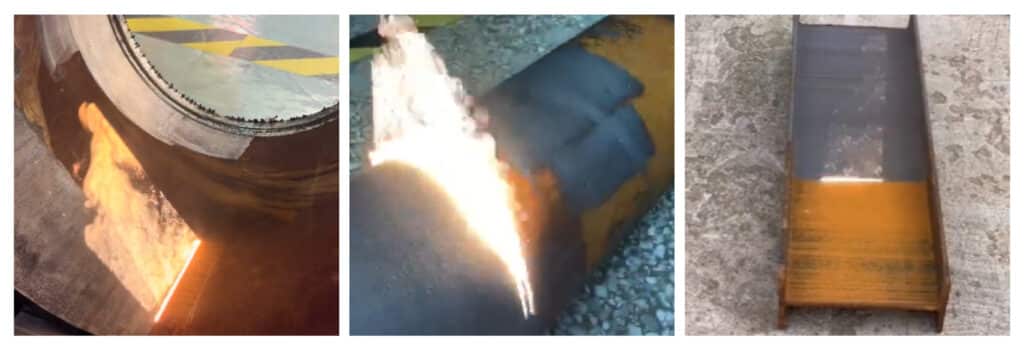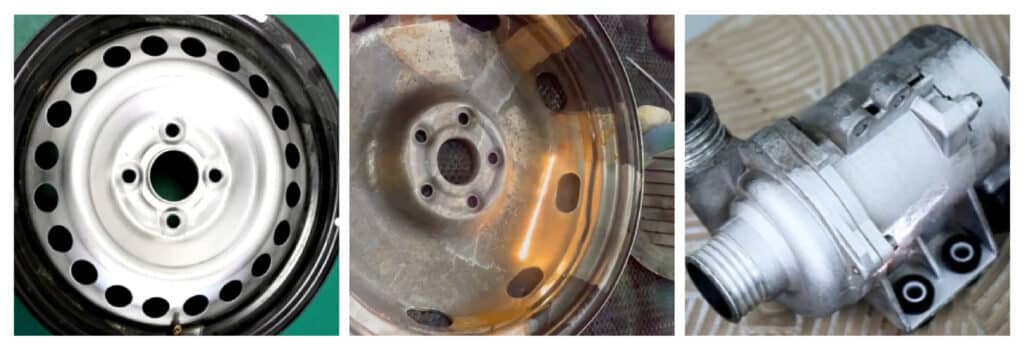Laser cleaning applications are widely used in fields such as ships, auto repairs, rubber molds, high-end machine tools, rails, and environmental protection. It can effectively remove resin, paint, oil, stains, dirt, rust, coatings, plating, and oxide layers on the surface of objects. Different laser wavelength has their own characteristics in terms of interaction with materials, cleaning efficiency, and effect.
Different wavelengths for laser cleaning applications
| Laser wavelength | Application | Details | Advantages |
UV laser 200nm-400nm |
Semiconductor Manufacturing | Used to clean silicon wafers, photolithography masks and other sensitive semiconductor material surfaces to remove tiny particles and organic pollutants; | 1. High precision and low thermal impact, effectively removing organic pollutants; 2. Able to handle fine structures and fragile materials. |
| Electronic Component | Remove contaminants from circuit boards and delicate electronic components to avoid damage | ||
| Cultural Relics Protection | Used to clean dust, mold and pollutants on the surface of cultural relics, especially suitable for stone carvings, murals, etc. | ||
Visible laser 400-700nm |
General surface cleaning | Suitable for some non-specific cleaning tasks, such as cleaning surface contaminants from metals, plastics and other common materials | 1. The cleaning process is visible and easy to monitor; 2. It has a moderate degree of interaction with a variety of materials |
IR laser 700-1064nm |
Metal Cleaning | Commonly used to remove rust, oxide layers and coatings from metal surfaces. For example, Nd:YAG lasers (1064 nm) are widely used in industry to clean metal surfaces such as steel, stainless steel and aluminum. | 1. Good absorption for metals, suitable for cleaning thick pollution layers; 2. High energy output and high efficiency |
| Industrial cleaning | For mold cleaning, welding pretreatment and weld cleaning, and other heavy industrial applications. | ||
Mid-infrared laser 2-10 µm |
Organic material cleaning | CO2 lasers (10.6 µm) are used to remove polymers, rubbers, and some coatings and are suitable for cleaning non-metallic materials | 1. Strong absorption for organic materials and polymers, and can effectively remove non-metallic contaminants. 2. Able to clean complex structures and hard-to-reach areas. |
| Aerospace and automotive industries | Used to remove composite materials, rubber seals and coatings, it is widely used in the maintenance and manufacture of aircraft and automobiles. | ||
Far-IR laser 30-300 µm |
Special cleaning | Less commonly used for general laser cleaning, it is primarily used for cleaning of specific types of polymers and composite materials. | 1. Able to interact specifically with certain polymers and composites. 2. Able to penetrate and clean complex structures. |
Common types of laser cleaning applications
Ultraviolet laser has a short wavelength and high single photon energy, which can directly break the chemical bonds between materials. The materials are peeled off the surface in the form of gas or particles. The heat affected zone generated during the processing is small, which has unique advantages in micro-manufacturing, such as semiconductor materials such as Si and GaN, optical crystals such as quartz and sapphire, and polymer materials such as polyimide (PI) and polycarbonate (PC). It can effectively improve the manufacturing quality and is widely used in various industries and fields such as communications, optics, military, criminal investigation, and medical treatment.
The continuous fiber laser operates by pumping a doped optical fiber with high-power diode lasers, stimulating emission of coherent light within the fiber through the process of stimulated emission in a stable optical resonator configuration. The biggest advantage is that it can emit light continuously.
In actual laser cleaning applications, if the requirement for substrate damage is not high, continuous lasers can be selected, such as some large steel structures, pipelines, etc.

Pulsed laser cleaning works by using short, high-intensity laser pulses to remove contaminants from surfaces. The laser energy is absorbed by the contaminants, causing them to rapidly heat up, vaporize, or be ejected from the surface through a process called ablation. It is widely used in various industries, such as automotive manufacturing, electronic equipment, aerospace, semiconductor processing, etc. It can be used to remove various contaminants such as paint, oxides, welding slag, etc. The underlying material typically remains undamaged due to the precise control of laser parameters and the brief duration of the pulses, which limits heat diffusion, very suitable for cleaning objects with high surface requirements.

CO2 laser cleaning uses a continuous or pulsed beam of infrared light from a CO2 laser to remove contaminants from surfaces. The laser energy is absorbed by the contaminants, causing them to thermally decompose, vaporize, or be ejected from the surface. This process relies on the difference in absorption characteristics between the contaminants and the substrate.
Based on its unique wavelength, CO2 laser is the best choice for cleaning the surface of non-metallic materials such as glue, coating, and ink. For example, using CO2 laser to remove the composite paint layer on the surface of aluminum alloy will neither damage the surface of the anodized film nor reduce its thickness.
In summary, laser cleaning applications require consideration of “material composition”, “layer thickness”, “thermal effects” and “precision and control” to select the appropriate laser wavelength to ensure efficient removal of contaminants while protecting the integrity of the substrate.
